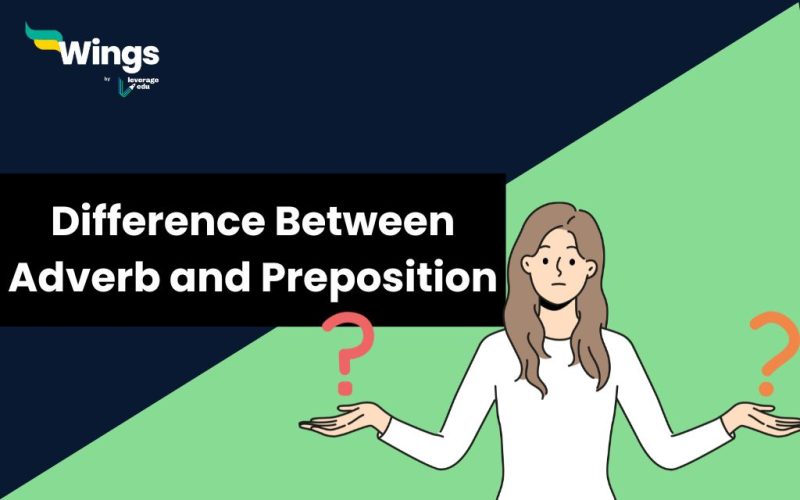English vocabulary is very complex. Often words like down, on, off, in, out and several others come in the prepositions group. Buy how many of you know that they can also be included as adverbs. Do you know the difference between adverb and preposition? Well, we have the answers. We have compiled an article listing all the differences between the two and how they should be used in sentences.
This Blog Includes:
What is a Preposition?
A preposition is a word or a group of words that are used before a noun, noun phrase or pronoun. Several types of prepositions are used in sentences. These include time, place, direction, location, spatial relationships or the introduction of an object. They are considered to be a state of the art that is used in a speech.
Examples
Here are some example sentences that can made using prepositions. Check them out.
- She ran down the street.
- They all sat and talked in circles resulting in no clear decision.
- Susan is looking out of the window.
Commonly Used Prepositions
Below is the list of commonly used prepositions that can be used in sentences.
Also Read: Prepositions: Definition, Types, Examples & Exercise
What is An Adverb?
An adverb is a word or phrase usually used to modify or qualify a verb, adjective, adverb or any other group of words. It can be used in place of time, place, circumstance, manner, cause or degree. Adverbs often end with -ly which is added at the end of the word. However, there are always some exceptions.
Examples
Here are some example sentences which have the commonly used adverbs.
- Peter is very tall.
- Unfortunately, Susan couldn’t record Tom’s win as her phone battery died.
- The horse race finished too quickly.
Commonly Used Adverbs
Find out the list of adverbs that can be used in making sentences.
Also Read: Adverbs: Definition, Types, Use, Examples & Exercises
Difference Between Adverb and Preposition
Preposition or Adverb? Are you one of those who often get confused between the two? Well, we have got your answers. Here is a simple differentiation between the two: Adverb and Preposition.
| Adverb | Preposition | |
| Definition | Adverbs are a part of the sentence that are used in modifying a verb, an adjective or a noun. Adverbs are made by putting a -ly at the end of the word. | Is a word placed before a noun or pronoun in a sentence. |
| Commonly Used Words | Commonly used adverbs include: occasionally, frequently, cheerfully, lastly etc. | Adverbs are a part of the sentence used in modifying a verb, an adjective or a noun. Adverbs are made by putting a -ly at the end of the word. |
| Types | Adverbs of Manner, Adverbs of Place, Adverbs of Time, Adverbs of Frequency, Adverbs of Degree | Preposition of Place, Preposition of Time, Preposition of Direction, Preposition of Location, Preposition of Movement |
What Makes Prepositional Adverb?
Prepositional Adverbs is an adverb that functions like a preposition. Unlike a common preposition, in a prepositional adverb, it is not followed by an object. It is used as a particle (a word that has a grammatical function but does not fit into the main parts of speech).
Unlike prepositions and adverbs, prepositional adverbs appear at the end of the sentence and not before nouns.
Here are some examples of prepositional adverbs that will give you a basic idea about the same:
- She left the keys on the table.
- Tina lives across the street.
- Reema studied until the midnight.
- We travelled by plane.
- The kids are playing by the river.
- They’re leaving in a few hours.
- He sings songs with passion.
Exercise on Adverbs & Prepositions (Download PDF)
Check Out More Blogs!
FAQs
Yes, we can put an adverb before a preposition to modify it. This rule applies mainly to prepositions of place and time.
Adverbs are usually placed before the main verb but after after auxiliary verbs. The only exception is, the verb must be “to be”. In that case, the adverb will be placed after the main verb.
The main rule of an adverb is that it modifies by answering questions like when, where, how and why. It then takes the form of -ly after the word.
To advance your grammar knowledge and read more informative blogs, check out our Learn English page and don’t forget to follow Leverage Edu.
 One app for all your study abroad needs
One app for all your study abroad needs















 60,000+ students trusted us with their dreams. Take the first step today!
60,000+ students trusted us with their dreams. Take the first step today!

